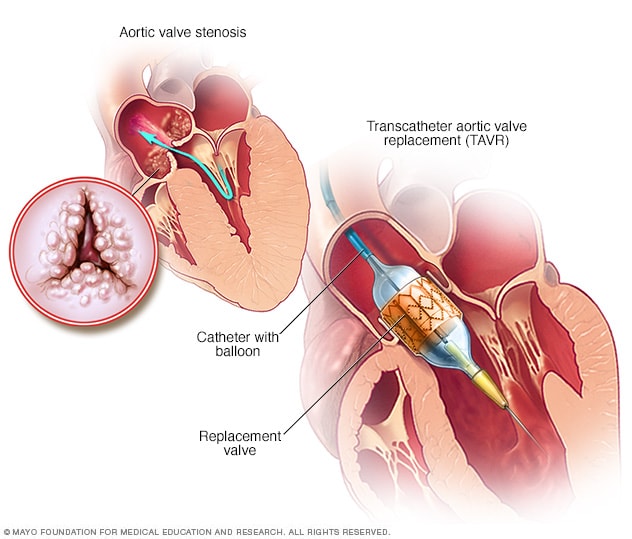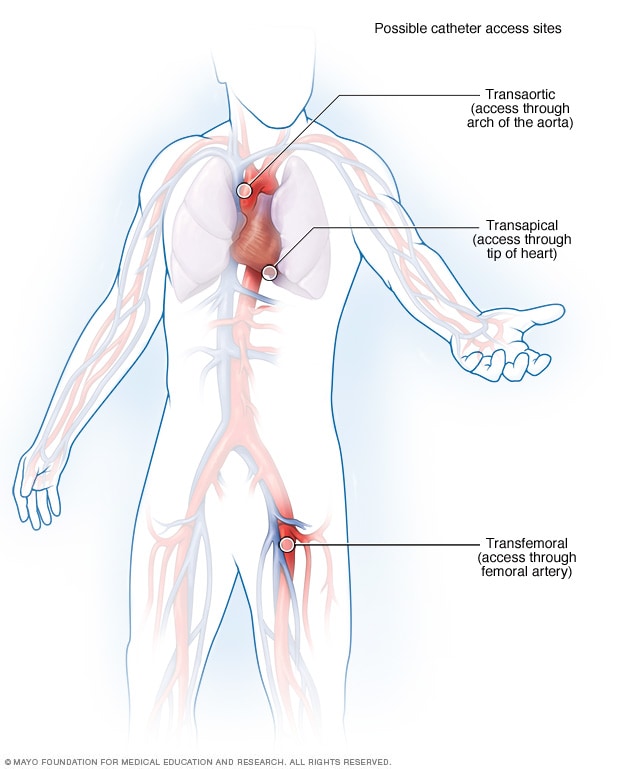Overview
Transcatheter aortic valve replacement (TAVR)

Transcatheter aortic valve replacement (TAVR)
Transcatheter aortic valve replacement, also called TAVR, is a type of heart valve surgery. It's done to replace a narrowed aortic valve. This is a condition called aortic valve stenosis. A doctor inserts a flexible tube called a catheter into a blood vessel and guides it into the heart. A replacement valve made of cow or pig tissue goes through the tube to the specific area in the heart. A balloon on the catheter tip inflates to press the new valve into place. Some valves expand on their own.
Transcatheter aortic valve replacement, also called TAVR, is a treatment to replace a narrowed aortic valve that doesn't open fully. The aortic valve is between the lower left heart chamber and the body's main artery. Narrowing of the aortic valve is called aortic valve stenosis. The valve condition blocks or slows blood flow from the heart to the body.
TAVR is minimally invasive. That means it uses smaller surgical cuts than open-heart valve surgery. TAVR may be an option for people who can't have open-heart surgery to replace the aortic valve. TAVR can help ease chest pain, shortness of breath and other symptoms of aortic valve stenosis.
The decision to have TAVR is made after talking with a team of doctors and surgeons who are focused on the heart. The team works together to figure out the best treatment for you.
Transcatheter aortic valve replacement also may be called transcatheter aortic valve implantation, known as TAVI.
What is TAVR?
Transcatheter aortic valve replacement, also called TAVR, is a minimally invasive treatment for aortic valve stenosis. This animation shows how TAVR is performed.
Here's how TAVR works:
A thin flexible tube called a balloon catheter delivers a collapsible replacement valve to the heart.
The new valve is placed inside the diseased valve and expanded — pushing the old valve leaflets out of the way.
The new valve works like a healthy one, restoring normal blood flow from the ventricle.
Advanced heart surgery options
[MUSIC PLAYING]
For generations patients with heart conditions have turned to Mayo Clinic or answers, offering the full spectrum of specialized care and treatment options.
Patients are surrounded by a team of heart experts to develop the strongest individualized treatment plans to provide the safest and most successful surgeries.
There are many ways to reach the heart for surgery. During traditional heart surgery, the surgeons open the chest to access the heart. With advancing technologies, minimally invasive robotic surgery options are now available to treat a variety of heart conditions. During minimally invasive surgery, the heart is reached through tiny chest incisions.
The surgical team at Mayo Clinic will recommend a unique care plan for each individual patient for best results focused on long-term outcomes. Together we are creating the future of heart care, one patient at a time.
[MUSIC PLAYING]
Products & Services
Why it's done
Transcatheter aortic valve replacement, also called TAVR, is a treatment for aortic valve stenosis. In this condition, also called aortic stenosis, the heart's aortic valve thickens and becomes stiff and narrow. As a result, the valve can't fully open and less blood flows to the body.
TAVR is an alternative to open-heart aortic valve replacement surgery. People who have TAVR often have a shorter hospital stay than those who have open-heart surgery.
Your healthcare professional may recommend TAVR if you have:
- Severe aortic stenosis that causes symptoms such as chest pain and shortness of breath.
- A replacement valve made from animal or human heart tissue that isn't working as well as it should.
- Another health condition, such as lung or kidney disease, that makes open-heart surgery too risky.
Risks
All surgeries and heart valve treatments come with some type of risk. Possible risks of transcatheter aortic valve replacement, also called TAVR, can include:
- Bleeding.
- Blood vessel injuries.
- Problems with the replacement valve, such as the valve slipping out of place or leaking.
- Stroke.
- Heart rhythm conditions and the need for a pacemaker.
- Kidney disease.
- Heart attack.
- Infection.
- Death.
Studies have found that the risks of disabling stroke and death are similar among those who have TAVR and aortic valve replacement surgery.
How you prepare
Your healthcare team gives you instructions on how to prepare for transcatheter aortic valve replacement, also called TAVR. Talk with your healthcare if you have any questions about TAVR.
Food and medications
Tell your healthcare team about all the medicines you take. Include medicines and supplements bought without a prescription. Also tell the team if you have allergies to any medicines.
Before having TAVR, ask your healthcare team if and when you can take your regular medicines.
Most people are told not to drink or eat for a certain amount of time before TAVR. Ask your healthcare team when you need to stop eating or drinking.
Clothing and personal items
You may be asked to bring the following items to the hospital:
- Eyeglasses, hearing aids or dentures.
- Personal care items, such as a brush or comb, toothbrush, and shaving equipment.
- Loose-fitting, comfortable clothing.
- Items that may help you relax, such as portable music players or books.
During your treatment, do not wear:
- Contact lenses.
- Dentures.
- Eyeglasses.
- Jewelry.
- Nail polish.
What you can expect
Before
A healthcare professional places an IV into your forearm or hand. Medicine called a sedative goes through the IV. The medicine helps you feel relaxed, calm or sleepy. Medicines to prevent blood clots and infection also may be given through the IV.
Your treatment team gives you medicine called an anesthetic to prevent pain. You may be given a local anesthetic that prevents pain in the treatment area. This is given along with a sedative. Or you may receive a combination of medicines that put you in a sleeplike state.
A member of your healthcare team may shave any hair from the area on your body where the treatment will take place.
During
Possible catheter access sites in transcatheter aortic valve replacement

Possible catheter access sites in transcatheter aortic valve replacement
Transcatheter aortic valve replacement, also called TAVR, is done using a flexible, hollow tube called a catheter. The doctor inserts the catheter into a blood vessel, usually in the groin or chest area. Sometimes, other methods are used to reach the heart.
During transcatheter aortic valve replacement, a doctor replaces a damaged aortic valve with one made from cow or pig heart tissue. The cow or pig valve is called a biological tissue valve. Sometimes, doctors place a biological tissue valve into an existing valve that no longer works.
TAVR uses small cuts and a flexible tube called a catheter to reach the heart. It's different from open-heart surgery to replace the aortic valve. That surgery requires a long cut down the chest.
In TAVR, a doctor inserts a catheter into a blood vessel, usually in the groin or chest area. The doctor guides the catheter to the site of the aortic valve in the heart using X-ray or other imaging tools as a guide.
The doctor sends a biological tissue valve through the catheter and places it near the aortic valve. A balloon on the catheter tip expands to press the new aortic valve into place. Some replacement valves expand without the use of a balloon.
The doctor removes the catheter once the new valve is securely in place.
During TAVR, your healthcare team watches you carefully. Your blood pressure, heart rate and rhythm, and breathing are checked constantly.
After
You may spend the night in a hospital's intensive care unit. That way, you can be watched carefully after your treatment. How long you stay in the hospital depends on many things. Some people who have TAVR might go home the next day. Less often, some go home the same day.
Before you leave the hospital, your treatment team tells you how to care for any wounds. Your team also tells you how to watch for signs of infection. These include fever, greater pain, swelling, and draining or oozing at the catheter site.
Some medicines may be prescribed after TAVR, including:
- Blood thinners, also called anticoagulants. This medicine helps prevent blood clots. Your healthcare team tells you how long you may need to take this medicine. Always take medicines as directed.
- Antibiotics. These medicines treat and prevent infections caused by bacteria. Germs can stick to or infect an artificial heart valve. Most bacteria that cause heart valve infections come from the bacteria in the mouth. Taking good care of your teeth and mouth can help prevent these infections. Get regular dental checkups. Antibiotics may be prescribed for use before certain dental treatments.
You need regular healthcare checkups and imaging tests after TAVR. These checkups help your healthcare team make sure that the new valve is working properly. Let a member of your care team know if you have any new symptoms or symptoms that get worse, including:
- Dizziness or lightheadedness.
- Swelling of the ankles.
- Extreme tiredness with activity.
- Swelling, change in skin color, tenderness or other infection symptoms at the catheter site.
Seek emergency medical help if you have:
- Chest pain, pressure or tightness.
- Severe, sudden shortness of breath.
- Fainting.
Results
Transcatheter aortic valve replacement, also called TAVR, may ease symptoms of aortic valve stenosis. Having fewer symptoms may help improve quality of life.
It's important to follow a heart-healthy lifestyle as you recover from TAVR. Such lifestyle habits also can help prevent other heart conditions. After TAVR:
- If you smoke, quit. You can ask your healthcare professional for help with this.
- Eat a heathy diet rich in fruits and vegetables and low in salt, saturated fats and trans fats.
- Get regular exercise. But talk with your healthcare professional before starting a new exercise routine.
- Stay at a healthy weight. Ask your healthcare team what a healthy weight is for you.
Clinical trials
Explore Mayo Clinic studies of tests and procedures to help prevent, detect, treat or manage conditions.
Aug. 12, 2025